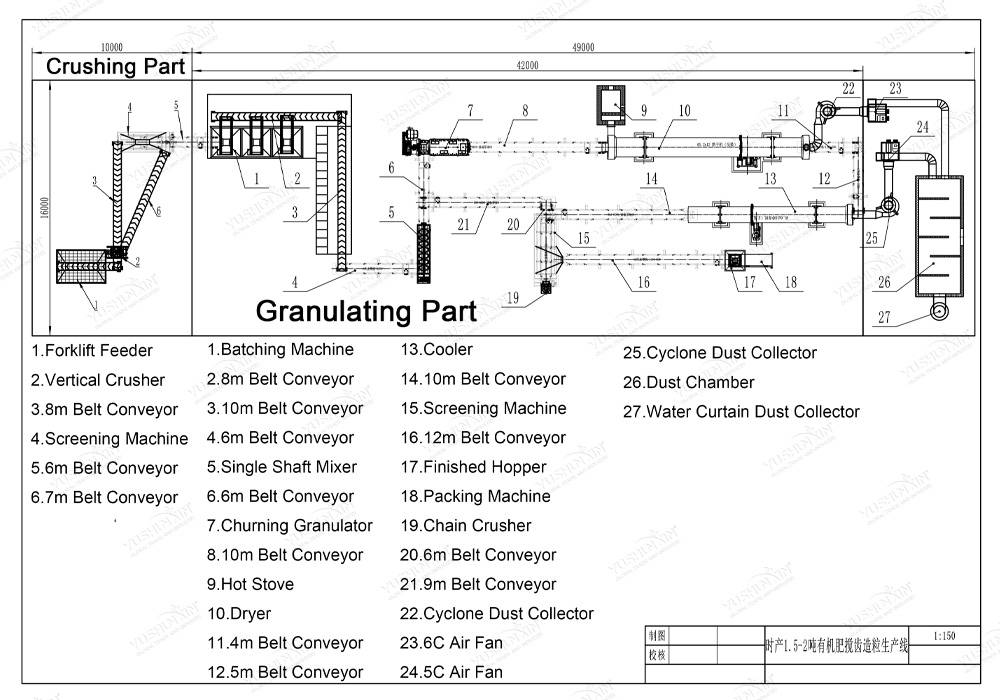








일반적인 유기 비료 원료
1. 가축 분뇨
– 닭 분뇨: 높은 질소 함량, 빠른 연기, 그러나 불타는 식물을 피하기 위해 완전히 분해되어야합니다..
– 돼지 분뇨: 유기물과 영양소에서 균형을 이룹니다, 일반적으로 유기 비료 재료로 사용됩니다.
– 소 분뇨: 높은 섬유 함량, 천천히 분해됩니다, 고 질소 물질과 혼합하기에 적합합니다.
– 양 분뇨: 높은 영양소 함량, 적당한 비료 효과로.
2. 산업 부산물
– 양조자의 곡물을 보냈습니다: 양조 후 잔류 물이 떠났다, 유기물과 질소가 풍부합니다.
– 설탕 공장 잔류 물: 바가스 및 사탕무 펄프와 같은, 탄소 함량이 높습니다.
– 식품 가공 폐기물: 콩 펄프와 같은 부산물이 포함됩니다, 과일 펄프, 전분 잔류 물, 등., 분해하기 쉽고 영양소가 풍부합니다.
3. 농업 폐기물
– 자르기 짚: 옥수수와 같은, 밀, 쌀 빨대, 등., 셀룰로오스와 유기물이 풍부합니다.
– 과일 껍질과 펄프: 땅콩 껍질과 같은, 코코넛 껍질, 사탕 수수 잔류 물, 등., 높은 탄소 대 질소 비율, 퇴비에서 탄소 질소 비율을 조정하는 데 적합합니다.
– 야채와 과일을 폐기합니다: 버릇없는 야채 잎과 같은, 과일 껍질, 등., 손상하기 쉽습니다, 그러나 높은 수분 함량으로주의를 기울여야합니다..
4. 도시 유기 폐기물
– 주방 쓰레기: 유기물과 영양소가 풍부합니다, 그러나 기름과 불순물과 분리되어야합니다.
– 진흙: 하수 처리장 슬러지, 중금속 오염이 없어야합니다.
– 정원 쓰레기: 낙엽과 같은, 가지 치기 나무 가지, 등., 탄소 함량이 높습니다.
5. 다른 원료
– 버섯 잔류 물: 버섯 재배 후 폐기물 기질, 유기물이 풍부합니다.
– 유일 케이크: 대두 케이크와 같은, 유채 케이크, 등., 질소가 높습니다, 고품질 유기농 비료 원료를 만듭니다.
원료 비율 원리
1. 탄소 대 질소 비율 (c/n) 조정
– 이상적인 탄소 대 질소 비율은입니다 25:1~ 30:1.
– 고 탄소 재료 (예를 들어, 빨대, 나무 칩) 고 질소 물질과 혼합해야합니다 (예를 들어, 가축 분뇨, 대두 케이크) C/N 비율의 균형을 맞추기 위해.
2. 수분 조절
– 재료의 수분 함량은 50% 그리고 60%. 수분이 너무 높거나 낮은 수분은 발효 과정에 영향을 미칩니다..
3. pH 조정
– 발효 중, pH는 그 사이에 유지되어야합니다 6.5 그리고 8.5. 라임 또는 산성 물질을 첨가하여 pH를 조정할 수 있습니다..
4. 발효 미생물의 첨가
– 미생물 제를 추가합니다 (*bacillus subtilis *와 같은, *actinomycetes*, 등.) 발효 과정을 가속화하고 퇴비화 효율을 향상시킬 수 있습니다..
환경 친화 성
에너지 효율
자동화 된 제어
맞춤형 비료 제형
고품질 과립 화
수분 조절
낮은 오염 및 냄새 제어
유연한 용량
고효율 및 수율
최소 노동 요건
고급 건조 및 냉각 시스템
지속 가능성
각 생산 라인의 비용은 생산 능력에 따라 다릅니다., 자동화 정도, 그리고 구체적인 요구. 아래 양식을 작성하면 정확한 견적을 제공합니다.!
비료 제조 장비에 관심이 있다면, 요구 사항 및 연락처를 제출하면 이틀 후에 연락 드리겠습니다.. 우리는 귀하의 모든 정보가 누구에게나 유출되지 않을 것을 약속합니다..
- 회사는 설립되었습니다 2005 유기농 비료 장비의 연구 개발 및 제조에 중점을두고 있습니다. 20 연령. 그것은 40,000m 대규모 유기농 비료 장비 생산 기반을 건설했습니다., 고급 과립을 사용합니다, 생산 효율성 및 제품 품질 향상을위한 건조 및 선별 기술.
- 자체 운영 수입 및 수출 기업 80 전 세계 전문 엔지니어, 더 많은 서비스를 제공합니다 100 전 세계 국가 및 지역, 5,000+ 고객 서비스 사례, 10 처리 센터, 3 레이저 절단 기계, 그리고 더 이상 60 다양한 유형의 장비.
- 많은 과학 연구소 및 대학과의 장기적이고 광범위한 협력 유지, with a professional R&D team, 시장 수요에 따라 장비 성능을 지속적으로 최적화 할 수 있습니다..
- 고강도 내마비 재료, Carbon Steel Q235/합금은 장비가 내구성이 있고 유지 보수 비용을 줄이기 위해 선택됩니다..
- 생산 자동화 수준을 향상시키고 수동 의존성을 줄이기 위해 지능형 제어 시스템 채택.
- ISO, CE, SGS 국제 인증
- 대규모 생산 능력으로, 다양한 생산 능력 요구 사항을 충족 할 수 있습니다 (작은, 중간 및 대형 생산 라인).
- 모든 장비 모델, 유기 비료와 같은 다양한 유형의 비료 생산에 적합합니다., 복합 비료, 생물학적 비료, 수용성 비료, 액체 비료, 등.
- 개인화 된 설계는 고객 요구에 따라 제공 될 수 있습니다, 생산 능력을 포함하여, 사이트 레이아웃, 환경 보호 표준, 등.
- 완전한 생산 라인 솔루션 세트를 제공하십시오, 장비 선택을 포함하여, 설치 및 시운전, 기술 교육, 등.

- 직접 공장 공급, 중개인 링크 감소, 그리고 가격은 더 경쟁력이 있습니다.
- 장비의 에너지 효율이 높습니다, 에너지 소비를 줄입니다, 고객이 장기 운영 비용을 줄이는 데 도움이됩니다.
- 직접 공장 공급, 중개인 링크 감소, 그리고 가격은 더 경쟁력이 있습니다.
- 장비의 에너지 효율이 높습니다, 에너지 소비를 줄입니다, 고객이 장기 운영 비용을 줄이는 데 도움이됩니다.